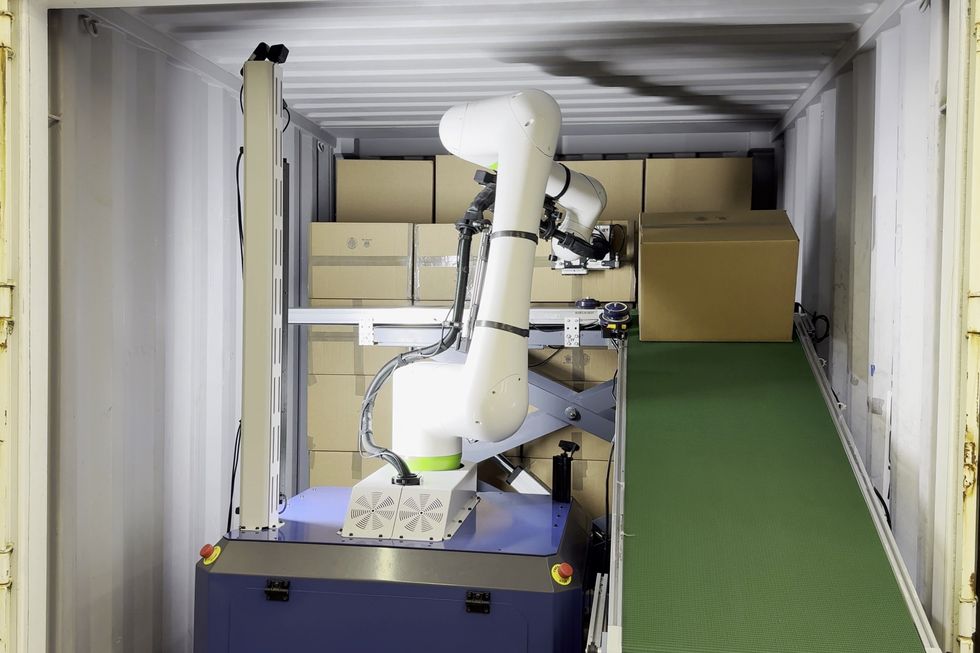[ad_1]

You’ve seen this earlier than: a truck unloading robotic that’s made up of a cell base with an arm on it that drives up into the again of a trailer after which makes use of suction to seize stacked containers and put them onto a conveyor belt. We’ve written about a few the businesses doing this, and there are much more on the market. It’s simple to know why—trailer unloading includes a reasonably structured and managed atmosphere with a really repetitive process, it’s a tough job that sucks for people, and there’s an infinite quantity of demand.
Whereas it’s doubtless true that there’s sufficient room for a complete bunch of various robotics corporations within the trailer unloading area, a given buyer might be solely going to select one, they usually’re going to select the one that gives the suitable mixture of security, functionality, and value. Anyware Robotics thinks they’ve that blend, aided by a field dealing with answer that’s each very intelligent and so apparent that I’m questioning why I didn’t consider it myself.
The general design of Pixmo itself is pretty customary so far as trailer unloading robots go, however a few of the particulars are fascinating. We’re instructed that Pixmo is the one trailer unloading system that integrates a heavy-payload collaborative arm, really a reasonably new business arm from Fanuc. Because of this Anyware Robotics doesn’t need to faff about with their very own {hardware}, and likewise that their robotic is arguably safer, being ISO licensed protected to work straight with individuals. The bottom is customized, however Anyware is contracting it out to an enormous robotics OEM.
“We’ve put plenty of effort into ensuring that many of the parts of our robotic are off-the-shelf,” co-founder and CEO Thomas Tang tells us. “There are already so many mature and cost-efficient suppliers that we wish to offload the availability chain, the certification, the reliability testing onto another person’s shoulders.” And whereas there are a number of automated cell robots (AMRs) on the market that appear like they might get the job achieved, the issue is that they’re all designed for flat surfaces, and moving into and out of the again of the trailer typically includes a brief, steep ramp, therefore the necessity for their very own design. Even with the customized base, Tang says that Pixmo could be very value environment friendly, and the corporate predicts that it will likely be roughly one third the price of different options with a payback of about 24 months.
However right here’s the actually intelligent bit:
Anyware Robotics Pixmo Trailer Unloading
That conveyor system in entrance of the containers is an add-on that’s utilized in assist of Pixmo. There are two advantages right here: first, having the conveyor add-on aligned with the bottom of a field minimizes the quantity of lifting that Pixmo has to do. This permits Pixmo to deal with containers of as much as 65 lbs with a lift-and-slide method, placing it on the high finish of trailer unloading robotic payload. And the second profit is that the add-on system decreases the gap that Pixmo has to maneuver the field to simply about as small as it might probably presumably be, eliminating the necessity for the arm to rotate round to position a field on a conveyor subsequent to or behind itself. Decreasing this cycle time implies that Pixmo can obtain a throughput of as much as 1,000 containers per hour—about one field each 4 seconds, which the Web suggests is sort of quick, even for knowledgeable human. Anyware Robotics is introducing this add-on system at MODEX subsequent week, they usually have a patent pending on the thought.
This looks like such a easy, helpful concept that I requested Tang why they have been the primary ones to provide you with it. “In robotics startups, there tends to be a legacy mindset concern,” Tang instructed me. “When individuals have been engaged on robotic arms for thus a few years, we simply take into consideration methods to use robotic arms to unravel every part. That’s possibly that’s the explanation why different corporations didn’t provide you with this answer.” Tang says that Anyware began with far more difficult add-on designs earlier than discovering this answer. “Often it’s the simplest answer that has probably the most trial and error behind it.”
Anyware Robotics is concentrated on trailer unloading for now, however Pixmo might simply be tailored for palletizing and depalletizing or considerably much less simply for different warehouse duties like order selecting or machine tending. However why cease there? A cell manipulator can (theoretically) do all of it (virtually), and that’s precisely what Tang desires:
In our long-term imaginative and prescient, we consider that the longer term can have two several types of basic function robots. In a single route is the humanoid type, which is a very versatile answer for jobs the place you wish to substitute a human. However there are such a lot of jobs which can be simply not cheap for a human physique to do. So we consider there must be one other type of basic function robotic, which is designed for industrial duties. Our design philosophy is in that route—it’s additionally basic function, however for industrial functions.
At simply over one yr outdated, Anyware has already managed to finish a pilot program (and convert it to a purchase order order). They’re at present in the midst of a number of different pilot packages with main third-party logistics suppliers, they usually anticipate to spend the subsequent a number of months specializing in productization with the purpose of releasing the primary business model of Pixmo by July of this yr.
From Your Website Articles
Associated Articles Across the Net
[ad_2]


